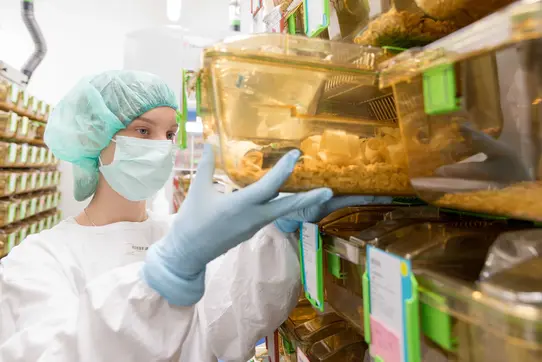Why we cannot do without animal testing in cancer research
The desire to completely replace animal testing in cancer research is understandable. However, this demand cannot be implemented at present or with concrete milestones. In biomedical cancer research in particular, animal experiments are still absolutely essential, at least for the time being.

According to the WHO, we will see a 20% increase in annual cancer cases in Germany and Europe within 20 years. The task of cancer research is to develop effective prevention and early detection for the increasing number of patients, through to innovative diagnostic procedures and effective treatment options.
In order to make progress in these areas, we at the German Cancer Research Center are already using all available methods and model systems: We conduct research on molecules and proteins, on cell and tissue cultures, on tissue samples, organoids and with computer models. Epidemiological and imaging studies also provide valuable results. But cancer is a disease that affects the whole body. As the tumor grows and spreads, the cancer cell comes into close contact with countless other cells and tissues in the body. All these interactions contribute significantly to the development and progression of cancer. Research into this high level of complexity cannot be tied to a fixed schedule and can only be carried out in an intact organism, which means that we will not be able to do without animal studies in cancer research in the foreseeable future.
Hellmut Augustin, Head of the Department of Vascular Oncology and Metastasis
"Without blood and lymph vessels, cancer could not spread in the body and form metastases. We are therefore investigating the molecular interactions through which tumor cells come into contact with the cells of the vascular walls. We want to find out how this ominous process can be interrupted and the progression of cancer halted. To this end, we have been working with so-called vascular organoids for more than 25 years. These are three-dimensional cell constructs that we use to mimic the structure of the vascular wall in the culture dish. We can actually use them to answer many questions. However, the complexity of the interactions of cells in the whole organism during metastasis and under the influence of blood circulation can only be simulated to a limited extent in cell culture. We are therefore still dependent on studying metastasis in mice. Our results from several decades of research in cell culture and in mice have been fully confirmed in humans."

An outstanding success for innovative cancer research - which would not have been possible without the use of animal testing - is the development of immune checkpoint inhibitors: the active substances, also known as "immunotherapy", were awarded the Nobel Prize in 2018. Some spectacular successes have been achieved with these innovative drugs, and they give many patients new hope in their fight against cancer due to their remarkable effectiveness.
The legal obligation to replace the use of animals when new animal-free methods become available is already firmly anchored in EU legislation and enables a gradual and therefore sensible approach hand in hand with scientific progress. The existing legal requirements for the performance of animal experiments rightly stipulate an extremely strict weighing up of the benefits and harm to the animals as well as the ethical justifiability of animal experiments.
Ana Martin Villalba, Head of the Department of Molecular Neurobiology
"In our laboratory, we are looking for ways to stop the growth of glioblastomas, among other things. These are very malignant brain tumors that almost always return after surgery. We want to know which active substances can stop the tumor or make it vulnerable to attack by the immune system. We carry out these investigations on so-called "tumor explants". These are tumor tissue samples obtained during biopsies that we can keep alive in the culture dish for a week. With this experimental model, we can achieve important initial results. But one week is far too short to recognize what effect the test substance has over a longer period of time. In order to be able to assess the effect on the tumor over a longer and more meaningful period of time, we are dependent on experiments on mice."

Animal experiments may only be carried out by personnel with the appropriate proven knowledge and require prior application and approval from the authorities. They are subject to the German Animal Welfare Act, one of the strictest in the world, as well as constant and close monitoring by animal welfare officers, veterinary offices and local authorities.
However, the understandable desire and demand to completely replace animal testing does not change the reality of what is scientifically possible today. The development of alternative methods would also be delayed without animal testing, as these ultimately always have to be tested against studies on animals. The transition to animal-free research can only take place if a fully-fledged methodological replacement is available.
This will require continued major efforts in basic biomedical research. We are facing up to this responsibility and the associated challenges.
Stefan Pfister, Director of the Hopp Children's Tumor Center (KiTZ) in Heidelberg and Head of the Department of Pediatric Neurooncology at the DKFZ
"There are only a few innovative therapy developments for cancer in children compared to adults. That's why we at the Hopp Children's Cancer Center Heidelberg (KiTZ) are concentrating on developing new diagnostic and therapeutic approaches specifically for young cancer patients. We are already using tissue samples that grow into mini-tumors in the laboratory as patient-specific test models in order to be able to carry out high-throughput drug tests with numerous drugs simultaneously. For children in whom standard therapies are no longer effective, we may be able to open up another treatment option. However, in order to be able to specifically develop new therapies for cancer in children, their effects and side effects must also be investigated in suitable animal models. In contrast to the mini-tumors, the therapeutic agents are metabolized in animals, which is why this is the only way we can assess, for example, the effects in the tumor or the toxic side effects on a young, still developing body. If this step were skipped altogether, we would have to expose children with cancer directly to these potential dangers."

Jens Puschhof, Research Group Leader Epithelial-Microenvironment Interactions, Dept. of Microbiome and Cancer
"Our laboratory develops miniature organs, so-called organoids and organ chips, to model the behavior of human tumors. This enables us to develop targeted therapeutic approaches for patients and even study complex relationships, such as the influence of bacteria on cancer development, in detail.
These novel approaches give us an important patient-centered perspective and allow us to reduce animal experiments further and further. Nevertheless, some cancer processes can still only be comprehensively mapped in mice. Organoid research and animal experiments are not opposites, but together enable the development of new cancer therapies."